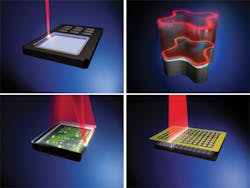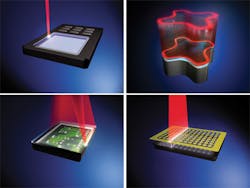Beam shaping for enhanced laser plastic welding
Powerful beam shaping elements find their way into laser plastic welding
Daniel Vogler
Laser polymer welding is a vibration-free, contact-less, and very precise method for joining plastic components.[1,2] Nowadays, four concepts for laser transmission welding are well-established (Figure 1). In contour welding, a focused laser beam is guided along a predetermined welding pattern. Thereby, two clamped plastic components are locally melted and joined. In quasi-simultaneous welding, two scan mirrors deflect a laser spot several times along a contour at very high speed. In this way, the pattern is heated and joined about simultaneously. In simultaneous welding, the entire contour is melted and joined simultaneously by a laser beam featuring the complete shape of the welding pattern. In mask welding, a laser line is moved across a reflective mask shadowing areas below that are not intended to be joined.
Circular M-shaped intensity profile
In contour and quasi-simultaneous welding, a glass fiber end-facet is typically imaged with an appropriate magnification onto a work piece. Normally, such an image features a top-hat; in other words, a flat-top profile. However, the continuous guidance of a circular flat-top profile along a welding pattern results in an inhomogeneous energy input across the guided direction. The energy input is higher in the middle than at the edge of the line. As a consequence, the use of a circular flat-top intensity profile in laser polymer welding results in an inhomogeneous temperature distribution across the weld seam during the joining process. This restricts the size of the process window.
A more convenient laser spot intensity profile for contour and quasi-simultaneous welding is a so-called M-shape profile. The name is derived from the developing of the profile since a circular M-shape profile features a higher intensity at the edge than in the center of the laser spot. This profile ensures a homogeneous temperature distribution across the weld seam during the joining process. Figure 2 shows an M-shaped intensity profile and the corresponding heat affected zone in polypropylene featuring 0.5 wt-% carbon black. The heat penetration depth is about constant across the guided direction.
Intensity profiles of laser spots can be M-shaped either by refractive or diffractive beam shaping techniques. In the refractive approach, a specific bi-shaped lens is integrated in a fiber-coupled laser module in order to achieve an M-shaped intensity profile at the fiber end-facet.[3] The advantage of this method is based on the low optical power loss. However, the effective achieved intensity profile is only approximated to the M-shape profile.
In the diffractive approach, a so-called diffractive optical element (DOE) is positioned in the propagation path of a collimated laser beam. Very small structures on the surface of the DOE diffract the laser light in such a manner that a predefined shape and intensity profile is generated on the work piece (Figure 3). The diffractive approach has the advantage that both the size and intensity profile of the laser spot can be modified. In addition, no optical alignment of the DOE is required. Therefore, the change of the width of the weld seam is as easy and quick as the exchange of the DOE without changing any lenses and working distances. The drawback of the diffractive technique is the higher optical loss compared to the refractive approach and depending on the requirement, a high-brilliance laser source—a fiber laser—is required.[4]
Homogeneous laser line
Homogeneous laser lines are generated by micro-lens arrays dividing any collimated laser beam into multiple beamlets. After the arrays, each beamlet is focused to a laser line onto the work piece. The superposition of all of these focused beamlet lines results in a homogeneous laser line. In mask welding, homogeneous laser lines are used to weld any joining pattern within a plane.
Highly customer-specific beam shape
Simultaneous welding is highly preferred if a short process time and/or no moving parts are required. Depending on the complexity of the welding pattern, refractive or diffractive optical elements can be applied. Simple patterns like annulus shapes can be generated by special lenses, whereas more complex patterns like ellipses, squares, or—in principle—2D patterns can be generated by using DOEs. Every welding pattern is typically customer-specific, so DOEs for simultaneous welding are, too. Since the specific diffractive structure is etched into the surface of a glass substrate, a DOE is costly but affordable. In addition, the diffractive-generated beam shape of a DOE is fixed. This limitation can be overcome by the use of so-called liquid crystal on silicon (LCoS) displays acting as a programmable DOE.
Recently, a highly reflective LCoS display has been successfully applied for laser polymer welding (Figure 4). The display withstood an irradiated laser power of more than 100W. In addition, the shape and the intensity profile of a linear polarized laser beam could be modified on a work piece within seconds and without changing anything of the setup. This modification is equivalent to a quick adjustment of the weld seam width and to an optimization of the temperature distribution during the joining process.[5]
Summary
Refractive and diffractive beam shaping techniques find their way into laser plastic welding. In contour and quasi-simultaneous welding, circular M-shaped intensity profiles ensure a homogeneous temperature distribution across the weld seam during the joining process. For simultaneous welding, any 2D pattern can be generated by DOEs. In the future, LCoS displays will enrich laser polymer welding with a new flexibility in laser beam shaping.
Acknowledgement
Presentations, highlights, and further information about laser polymer welding can be found at www.polybright.eu.
References
1. A. Rösner and A. Olowinsky, "Laser welding of polymers," Industrial Laser Solutions, 28, 1, 23–31 (2013).
2. R. Klein, Laser welding of plastics, Wiley-VCH, Berlin, Germany (2011).
3. F. Legewie et al., "M-shaping of diode laser radiation as a process optimization for polymer welding techniques," presentation in EU Innovation Forum at AKL'12.
4. D. Vogler, "Beam shaping and simultaneous exposure by diffractive optical element in laser plastic welding," presentation in EU Innovation Forum at AKL'12.
5. D. Vogler, "New prototype machine for polymer laser welding featuring a highly variable LCoS beam shaping system," Polybright highlight (Mar. 2013).
DR. DANIEL VOGLER ([email protected]) is the head of the optics team at Leister Technologies AG-Kägiswil, Switzerland.




